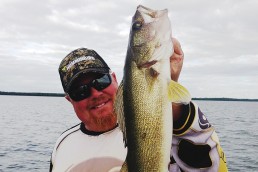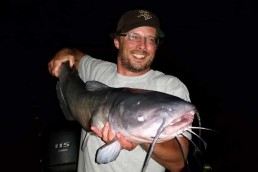Learning to Pattern Summer Walleyes
SHARE THIS POST
A walleye is a walleye, no matter where you find them in the U.S. or Canada. How the walleyes react to their environment can vary greatly between lakes too. These have split personalities, but can adapt to many different situations. Walleye anglers have to learn to pattern this species based on the predator-prey relationship. Once you find them, you have to use presentations that fit the situation to catch these fish consistently.
Most innovations in walleye fishing have come from tournament anglers and guides who make their living catching walleyes. Tournament anglers need to find the big walleyes and also the largest- slot fish and be able to catch them in order to make money and get sponsors. And, guides need to produce fish for their clients on a daily basis in all types of weather so they can make their customers happy and keep their calendars filled.
The predator-prey relationship is the key to walleye location in most situations except the spawn. Walleyes are constantly searching for the best feeding opportunities, so their location changes constantly during the summer. These fish need to stay close to an abundant food source at all times. The schooling nature and superior eyesight of the walleye is its biggest advantage over prey and allows it to thrive in many different environments.
Each lake has their own unique set of circumstances with a forage base that usually provides walleyes with several different feeding opportunities. Most fish spawn in the spring, while whitefish, tullibees, char, salmon and some trout species are the notable fall-spawning exceptions. Walleyes spawn early, so by the time they are done there are baitfish species like shiners just moving into the shallows to spawn. This gives walleyes their first post-spawn feeding opportunity in most lakes. Spottail and emerald shiners are the key forage for these walleyes some lakes, while yellow perch, smelt, herring or other baitfish may be the forage for them in others.
There is a pecking order that develops in lakes with several different species of gamefish, and this can have an effect on a walleye’s location. The walleyes may have to compete for habitat with species like pike, smallmouths and largemouths, muskies, catfish and even trout and salmon. But each gamefish stakes their claim to different feeding areas in lakes. Fish often share feeding areas with other species too, especially on lakes where suitable habitat and forage options are limited.
Cabbage weed beds are a good example of such an area. Walleyes, northern pike, muskies and bass may all use different parts of a weed bed or may use the same areas at different times of the day. Hypothetically speaking, the bass could use the inside edges of the weeds, the pike could use the ambush points on flats or inside turns, and muskies usually come and go where they please. This leaves walleyes the deep weed edges and points, with them also capable of turning into night feeders and using the same areas then.
Walleyes in inland lakes relate to the bottom most of the time, and at least during the day. They like hard-bottomed areas and will feed on yellow perch, shiners and other minnows along with crayfish and insects, depending on where the best feeding opportunities are located.
Are you enjoying this post?
You can be among the first to get the latest info on where to go, what to use and how to use it!
Walleyes in the Great Lakes usually feed their way out of the adjacent rivers after they spawn and then feed their way into the basin of the lakes. They usually follow the schools of pelagic baitfish wherever they go during the summer, especially June.
The next best feeding opportunity after baitfish are done spawning on shoreline structure are the insect hatches in the mud basin. This gives walleyes a dependable food source as they leave the shoreline structure and disperse into the lake. After the insect hatches are done, summer-pattern walleyes will be more spread out than at any other time of the year, using both shoreline and mid-lake structures in the lakes.
The most abundant forage in the “preferred” size range for walleyes will attract the most fish. They are constantly searching for the best feeding opportunities, so the best areas for eating-sized walleyes to catch may be different than the best areas for the “larger” walleyes.
Most of the forage in the Great Lakes is suspended over the basin during the summer. Anglers use planer boards because of the clear water and the ability to spread out multiple lines. Most anglers troll either crankbaits or spinner rigs with nightcrawlers.
Using live bait for walleyes is a bigger deal in Minnesota, Wisconsin, North Dakota and South Dakota. Most walleye anglers on the inland lakes use presentations like jigs and minnows, live-bait rigs with large minnows or leeches or bottom bouncers and spinners with nightcrawlers. The nightcrawler is the most widely used live bait for this species in the country. They can legally be transported, are easy to keep, inexpensive to buy and can be found almost anywhere walleyes are located. Other good live baits for walleyes include leeches, shiners and premium minnows, like redtail chubs and creek chubs, but these are only available in a few locations.
I’m a big fan of using jigs for walleyes. I’ll use jigs and minnows, jigs and plastics, jigs and nightcrawlers or jigs and leeches in many different situations. I’ll also jig with Northland Puppet Minnows when walleyes are located in deeper water. Having the perfect rod for fishing jigs is absolutely critical to getting the right action and having the proper power to set the hook. I love the St. Croix Legend Extreme medium-action rod for jigs from 1/8 to 1/2 ounce, and I use the exact same rod in the Legend Elite Series for Puppet Minnows.
Locating the weed beds and rock piles and seeing schools of baitfish and walleyes has never been easier than it is now with side-imaging technology. But anglers should strongly consider hiring a good guide to help them learn how to read their electronics properly and get dialed in to what the walleyes are doing during their vacation.
MWO
SHARE THIS POST
Did you enjoy this post?
You can be among the first to get the latest info on where to go, what to use and how to use it!
Brian 'Bro' Brosdahl
Outdoor communicator Brian “Bro” Brosdahl lives in northern Minnesota. He is a walleye guide in the Cass Lake, Leech Lake and Lake Winnibigoshish areas. He is sponsored by Northland Fishing Tackle, Frabill/Plano, Aqua-Vu, Humminbird/Minn Kota, St. Croix Rods, Ranger Boats, and Evinrude. Guide inquiries: brosguideservice.com. Follow on social media.



